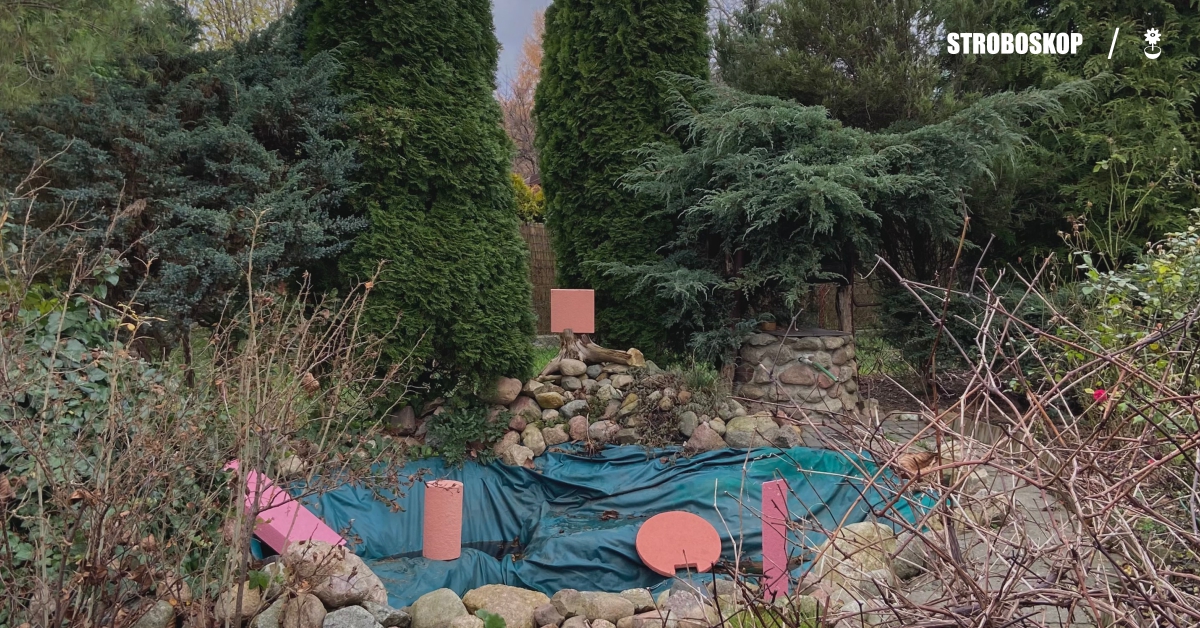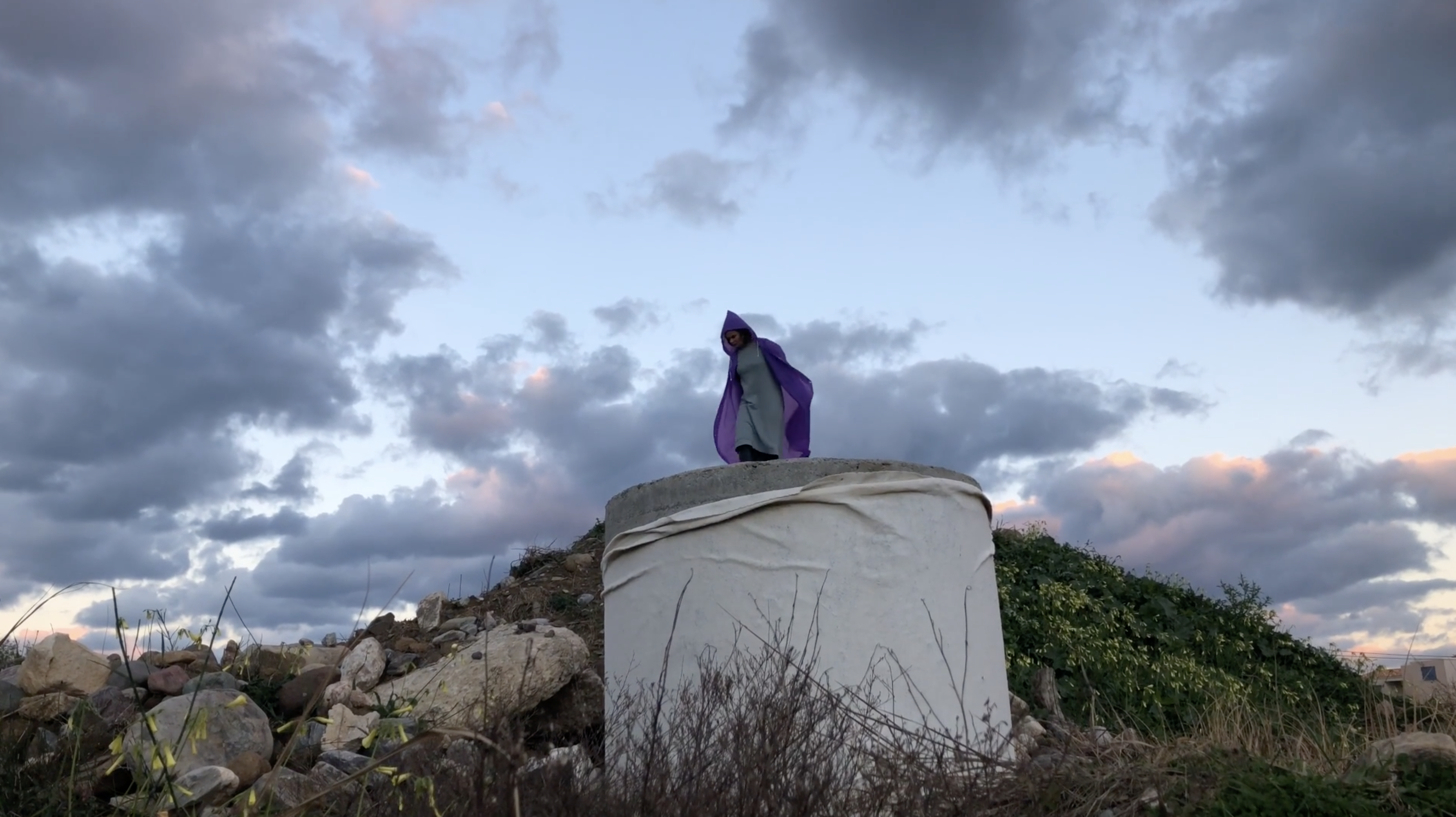Zuzanna Piętkowska + Alka Nauman
Baranek | 07-28.05.2021








Baranek is the collaboration between artist/set designer Zuzanna Piętkowska and performer/choreographer Alka Nauman, that was developed for The Zelmot Experiment1. What began as a one-month residency transformed into a multi-tiered, process-based research project commenced between Piętkowska and Nauman that has ultimately centered on the exploration of relationships: between place, between people, between ideas and ways of working.
Opening Friday, 07.05.21 18:00-21:00
Guided Walk in ROD Zelmot Sunday, 23.05.21 14:00-15:00 (details here)
‘Baranek’, by definition, is a plastering technique that is most commonly used to renovate the exterior of modernist-style apartment bloks, the name for this signature gnarled, popcorn-like surface texture aptly translates to ‘lamb’, referring to the animals’ characteristic coat. This unique effect is achieved by using an acrylic plaster aggregate which is applied to the surface using a trowel and a spatula, and through a repetitive gesture of scooping up, drawing off the excess and applying with a sweeping motion, to the surface of the object. The gestures related to this process have formed the basis of the work between Piętkowska and Nauman, namely the body/the physical act of plastering, the play between subject/object (read: body/architecture), and the notion of façade.
Piętkowska defines Baranek as a project that does not assume a critical position, but rather employs curiosity to explore what is happening when planned architecture meets spontaneous, playful human response. Focusing on color schemes and geometries, it is a searching for unexpected relationships between shapes, colors, and textures, and creating situations (objects+compositions in situ) which echo constructivist compositions. Piętkowska also plays with the notion of ‘pasteloza’2 in relation to the façade: and the gap that exists between the public-facing dream-like color and the more private realities, these two “naive" aesthetic sensibilities that are present in the Zelmot landscape. Through the objects, Piętkowska creates tender stories about public spaces in which the protagonist is often played by the typically overlooked, seemingly un-aesthetic object.
For Nauman, Baranek has been a ‘dialogue between sensibilities.’ Despite not being physically in the garden (she experienced a pandemic-related temporary relocation), Nauman found that she was able to continue this thread by mediating the work of Piętkowska, using her sculptures as vessels, and the screen as both site and medium through which to explore the gesture of the shapes and spaces she found herself occupying. Nauman has used her body as a tool in these spaces, collaborating with the objects and architectures that echoed her metamorphosing memories of Zelmot.
During the course of the collaboration, images, performances, sculptures, videos, an instagram account (@baranek_pamietnik), and countless other gestures have been created and enacted in the name of Baranek. For its ‘final’ iteration, Piętkowska has staged an installation that brings the shapes, tones, textures, and feelings of ROD Zelmot, to Stroboskop. Using her language as a set designer (one half of the duo Piękna), she has channeled all of these vibrant, haptic elements into an enterable façade. There is a marked front of house and back, each revealing different elements of the collaboration. From the front, the act unfolds through an abstracted dreamscape of Zelmot. Once ‘backstage’ we gain access to a series of videos by both Piętkowska and Nauman, and are reoriented again in the prosaic space of a garage, in the heart of the slightly less-romantic neighborhood of Ochota. To compliment the exhibition, Nauman will lead a performative walk through ROD Zelmot, details of which will be announced separately. And finally, a small archive of images will be presented in the public announcement vitrine located at the main gate of ROD Zelmot.
Baranek is a nostalgic, aesthetic, experimental lens through which a specific place and time are observed and consumed, digested and distilled. It is a negotiation and collaboration between shapes, colors, gestures and bodies that are simultaneously lived and remembered.
1The Zelmot Experiment was a one-time artist residency created in October 2020 for Naprzód działki as a collaboration between Stroboskop Art Space and SAM Rozkwit. Naprzód działki was supported by Zieleń Warszawska (The Greenery Department of the City of Warsaw).
2pasteloza is an informal term referring to the painting style often seen used on post-Soviet housing blocs throughout Poland
A selection of works from this project will be on view in Stroboskop from May 7- May 28, 2021, a Situationalist-style, architecture-yoga walk led by Alka Nauman will be held at ROD Zelmot on Sunday, May 23. We will meet at the front gate of Zelmot at 14:00 and go through the garden together.
Co-organizers:
SAM Rozkwit: https://www.instagram.com/sam_rozkwit/
Naprzod Działki: https://www.instagram.com/naprzod.dzialki/
Zielen Warszawska: http://zzw.waw.pl/
ROD 'Zelmot': https://rodzelmot.pl/
(PL)
Baranek to współpraca między artystką/ scenografką Zuzanną Piętkowską i performerką/ choreografką Alką Nauman, która powstała w ramach The Zelmot Experiment1. To, co zaczęło się jako miesięczna rezydencja, przekształciło się w wielopoziomowy, oparty na procesie projekt badawczy, zainicjowany przez Piętkowską i Nauman, który ostatecznie przyglądał się relacjom między miejscami, ludźmi, ideami i sposobami pracy.
,,Baranek" z definicji jest techniką tynkowania stosowaną najczęściej na do renowacji zewnętrznych ścian modernistycznych bloków mieszkalnych. Nazwa tej charakterystycznej, sękatej i popcornowej faktury nawiązuje do sierści baranków. Unikalny efekt uzyskiwany jest dzięki zastosowaniu akrylowego kruszywa gipsowego, które nakładane jest na powierzchnię za pomocą kielni i szpachelki oraz poprzez powtarzalny gest nabierania, ściągania nadmiaru i nakładania zamaszystym ruchem na powierzchnię obiektu. Gesty związane z tym procesem stały się podstawą pracy Piętkowskiej i Nauman - cielesny/fizyczny akt tynkowania, gra między podmiotem a obiektem (czyli ciałem i architekturą) oraz pojęcie fasady.
Piętkowska definiuje Baranka jako projekt, który nie przyjmuje pozycji krytycznej, ale raczej z ciekawością bada, co dzieje się, gdy zaplanowana architektura spotyka się ze spontaniczną, zabawną reakcją człowieka. Skupiając się na kolorystyce i geometrii, poszukuje nieoczekiwanych relacji między kształtami, kolorami i fakturami, tworząc sytuacje (obiekty+kompozycje in situ), w których pobrzmiewają echa kompozycji konstruktywistycznych. Piętkowska bawi się również pojęciem ,,pastelozy "2 w odniesieniu do fasady i rozziewem, jaki istnieje między jawnym, marzycielskim kolorem a bardziej prywatną rzeczywistością ogródków, tymi dwiema ,,naiwnymi" wrażliwościami estetycznymi, które są obecne w pejzażu Zelmotu. Poprzez obiekty Piętkowska tworzy czułe opowieści o przestrzeniach publicznych, w których bohaterem jest często pomijany, pozornie nieestetyczny przedmiot.
Dla Nauman Baranek był ,,dialogiem między wrażliwościami". Mimo, że Nauman nie była fizycznie w ogrodzie (musiała się czasowo przeprowadzić, co związane było z pandemią), odkryła, że może kontynuować pracę mediując z twórczością Piętkowskiej, patrząc na jej rzeźby jako naczynia, traktując ekran jak miejsce oraz medium, badała kształty i przestrzeń, w których się znalazła. Nauman użyła w nowych przestrzeniach swojego ciała jako narzędzia, współpracując z obiektami i architekturą, przywołując echo wspomnień o Zelmocie.
W trakcie współpracy powstały obrazy, performance, rzeźby, wideo, konto instagramowe (@baranek_pamietnik) i wiele innych gestów wykonywanych w imieniu Baranka. W swojej „ostatniej” odsłonie Piętkowska zainscenizowała instalację, która przenosi kształty, tony, faktury i nastrój Zelmotu do Stroboskopu. Wykorzystując język scenografki, Piętkowska (połowa duetu Piękna) połączyła wszystkie te żywe, haptyczne elementy w fasadę, za którą można wejść. Od frontu i z tyłu znajdują się różne elementy współpracy artystek. Od frontu akcja rozgrywa się poprzez wyabstrahowany oniryczny pejzaż Zelmotu. Za kulisami mamy dostęp do serii filmów Piętkowskiej i Nauman, by ponownie znaleźć się w prozaicznej przestrzeni garażu, w sercu nieco mniej romantycznej Ochoty.
Baranek to nostalgiczna, estetyczna i eksperymentalna soczewka, przez którą obserwowane, konsumowane, trawione i destylowane jest konkretne miejsce i czas. To negocjacja i współpraca kształtów, kolorów, gestów i ciał, które jednocześnie przeżywają i zapamiętują.
1The Zelmot Experiment to jednorazowa rezydencja artystyczna stworzona w październiku 2020 roku dla Naprzodu działki w ramach współpracy Stroboskop Art Space i stowarzyszenia SAM Rozkwit. Naprzód działki zostały wsparte przez Zieleń Warszawską (Zarząd Zieleni m. st. Warszawy).
2pasteloza to nieformalny termin odnoszący się do stylu malarskiego często spotykanego na postsowieckich blokowiskach w całej Polsce